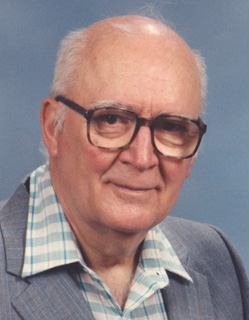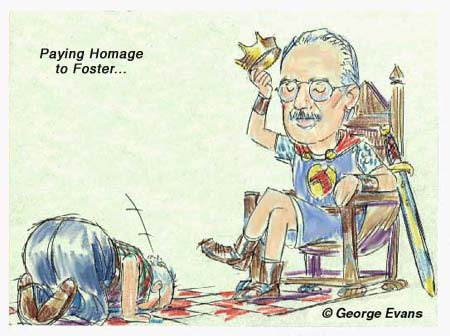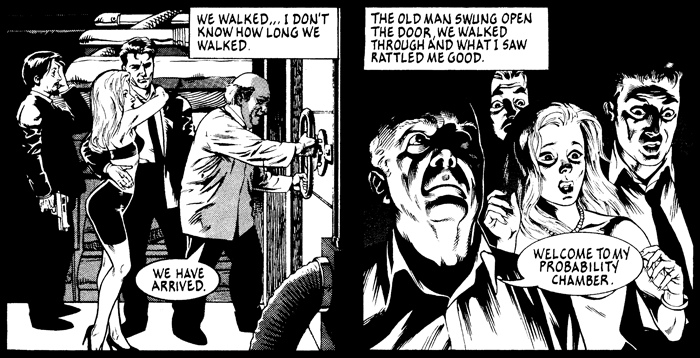GEORGE EVANS Q and A

GEORGE EVANS |
I was first introduced to George Evans' artistry while
working on staff at King Features Syndicate. Ignorant of the huge body
of work he had done, I was immediately drawn to the action-packed and
beautifully illustrated job he was doing on "Secret Agent Corrigan."
Striking up a correspondance, he was more than willing to try to assist
a newcomer trying to break into the field. He would even from time to
time send a package of xeroxes from his files of an artist he admired
(and thought I should be made aware of).
George Evans loved the art of comics. Even after a career
spanning over 50 years, George kept the same passion and love of the field as when he first began.
-Jim Keefe
|
Interview conducted in the Fall of 1999
Jim Keefe: Which comic strips did you get the most
kick out of growing up?
George Evans: Foster's "Tarzan" and "Prince
Valiant," "Flash Gordon," "Captain Easy," Caniff's
"Terry" and Noel Sickles' "Scorchy Smith." For Humor
out our way, "Blondie."
JK: Is there a strip you would have most liked
to work on?
George Evans: "Buz Sawyer," and it almost
might have been. When Buz Sawyer was relinquished by Schlensker I called
Bill Yates (head of King's Comic Art Department at the time) and asked
if he'd let me take that over. His answer was, "Jeez, then I'm
still left with the problem of who to get to do Corrigan." There
was a temptation to tell him, "Well you still have that problem
because it's Sawyer or I'm out," but then he told me old pal and
respected artist John Celardo was taking it on (who told me he HATED
it) so I stuck to Corrigan. I would have loved Sawyer for I think Roy
Crane was THE innovator. Even Caniff really derived from Crane as a
storyteller, and of course kid-Terry and tough soldier of fortune Pat
Ryan were close variants of runty Wash Tubbs and Captain Easy. Even
the oriental settings were derived from several swashbucklers Crane
set in the orient, replete with gorgeous women and crazy oddball characters
who were prototypes of the Dragon Lady, Klang and etc.
JK: What would be your list of the top five comic
strip or comic book artists?
George Evans: Foster, Raymond, Noel Sickles, Len
Starr and Al Williamson.

JK: I undertand you first ran into Al Williamson while
at Fiction House when he was a young artist just learning the ropes.
What was your first impression of him?
George Evans: I saw myself at that age.
JK: Who have you especially enjoyed working with
in the field?
George Evans: Williamson, Frazetta, Frank Springer,
Creig Flessel and John Prentice.
JK: During the early sixties, Frank Frazetta credits
you with bailing him out when he had trouble finding work. What is your
recollection of Frazetta from that time?
George Evans: I'd known Frank a bit. "Bailing
him out" is a kind recollection on his part. I was doing whole
books, somewhere around fifty pages, and he always helped me immensely
with great stuff.
JK: I heard
that at EC you were always at odds with Harvey Kurtzman because of the
tight layouts that accompanied scripts. Was it a difficult partnership?
George Evans: Not at all. I liked him, he liked
me. We LIKED to disagree and argue about ANYTHING! But on his overdone
layouts, I wouldn't be just Harvey's "hands".
JK: After EC Comics was forced to fold, you went
on to ghost "Terry and the Pirates" for the next thirteen
years. Were you eventually hoping to do your own strip?
George Evans: EC wasn't forced though
it's what they would have everyone believe. In truth, EC
and Bill Gaines could have kept on with business as usual (good sales,
faithful support) but Bill called us all together at the offices, and
this is a direct quote of that good man's words, "They say I'm
(we're) hurting kids. I don't believe it...but I don't want to hurt
kids, so I'm folding the whole lineup." I heard that personally.
JK: EC seemed well suited for you, especially with
their comics that featured vintage aircraft like "Aces High."
Did you ever have an opportunity or desire to do any of the superhero
characters while working at Marvel or DC?
George Evans: All the superhero stuff eludes me.
At D.C., editors urged me to take on pencilling or inking on Batman
and/or Superman because they paid a better rate page but I always felt
there HAD to be some interest besides just money in what you did or
it was a millstone around your neck.
JK: You've ghosted a number of strips including
"Terry" and "Rip Kirby"...in what ways did it prepare
you for taking the helm of "Secret Agent X-9"?
George Evans: I learned unrelenting commitment.
JK: What are the particulars of pacing for a comic
strip as opposed to a comic book?
George Evans: Comic book stories ran their committed
pages with the story and dialogue building to the tale's end. In strips,
you try to end each day's with a come-on to keep readers looking toward
the next day's strip.
JK: What were your solutions to the space limitations
of how small strips are reproduced today?
George Evans: Just try to make each picture strong
enough to tell its bit without resorting to just talking heads. Now
size almost precludes it.

Evans' creative use of panel layout - Secret Agrent Corrigan 4/20/1994
JK: Having a studio at home, what was your work
routine like?
George Evans: Schedules for
the Evans were a joke when I lived near the ocean (with kids who loved
that ocean), so I turned to night work and sleeping till noon. I wrote
Secret Agent while walking the dog - quietly strolling the nearby park
and empty streets of this ten o'clock bedtime community. With the specifics
of a story fixed in my mind I'd speak the copy, pruning it, finding
the right words. Couple of times I'd pass people who'd come out to have
a smoke in the open air, so there are probably people around here who
think of me as "that crazy old coot who walks around talking to
himself." A nut, and nuttier in that many a time I find I miss
doing it, for I sure enjoyed the business.
JK: What do you miss most?
George Evans: With the nitwit debacles going on
in Washington and the rising terroism worldwide, story material for
a Secret Agent begs to be used.
JK: What job have you done that you're particularly
proud of?
George Evans: I did several two-color interior
illos for the aviation slick "Air Trails."
WWI air-combat scenes. A labor of love, but the aviation mags were dying
fast.
JK: Which Illustrators do you most admire?
George Evans: If general commercial, Andrew Loomis,
von Schmidt and Edwin Georgi.
"Figure drawing For All It's Worth" by Andrew Loomis is, in
my opinion, the best anatomy book I know. Bridgeman, like Michaelangelo,
gives even the muscles in the eyelids ("that you can crack walnuts
with" - Bob Hope's line) and that's too damn much.
JK: If you weren't a cartoonist and illustrator,
what would you like to be doing?
George Evans: Well...STILL a cartoonist/illustrator,
if only for myself, but then a professional flyer. It was negated by
poor eyesight and a chronic heart murmur found at age ten or eleven.
I've been told that Dik Browne, when ill, was asked what
he thought heaven would be like and he said, "If St. Peter ushers
me through the Pearly Gates and simply says, "Your drawing board
and all your tools are right over here, Dik!", then I'd known I'd
gotten into heaven." I tell you honestly, I picked what I wanted
to do in life and feel I have been on an unending vacation. Maybe that's
jarred loved ones who yearned for different kinds, but I'm like the
Pop in Calvin & Hobbes. Rain or snow, fire or flood, good times
and lean, as long as I could make things live on once empty boards,
I couldn't ask for much more. I wish I might have fared better in money
or in circulation but in the end I was really doing what I did for ME.
And so although I urge my grandson Roger to explore the whole range
of commercial art, when he says "but I like comics, George!"
no way can I argue. Only wish him the best, the best, the Best!

"The Probability Chamber" - Artwork ©Roger Petersen
JK: I noticed that the story featured in "Death
Rattle" #1 (scripted by Mark Schultz) featured your likeness as
one of the main characters. What words of advice do you have for someone
like Roger just breaking into the field?
George Evans: Roger's talents and education should
have him doing every kind of painting, but he loves the comics medium
and is willing to work at it even for short bucks and heartbreaking
schedules. Recognize the type? So you stick to it, do your best and
keep hoping things pick up. Most of all, you hope that a lot of people
really get to see your product so that it can be judged fairly in this
strange nation where all the "experts" have opposing tried-and-FAILED
ideas but refuse to use one of the most powerful teaching/entertainment
mediums in the world.
In my early teens I had preschool twin siblings for whom
I read (the then) wonderful Sunday comics pages. Their friends began
to come and the comics got read multiple times. In later schooling,
every one of those wound up in the top part of their classes in every
subject. Several won top honors, including my brother and sister. My
own daughters did the same for their kids and they also did great at
school at all levels. There's a moral there but Educators
aren't having any of it. Figure why...
Back to George
Evans' Home Page
|